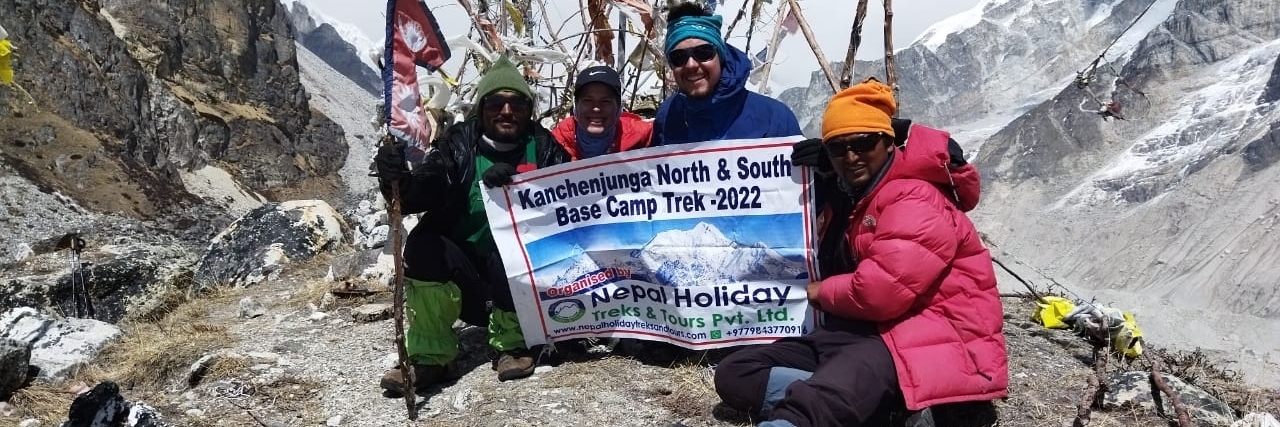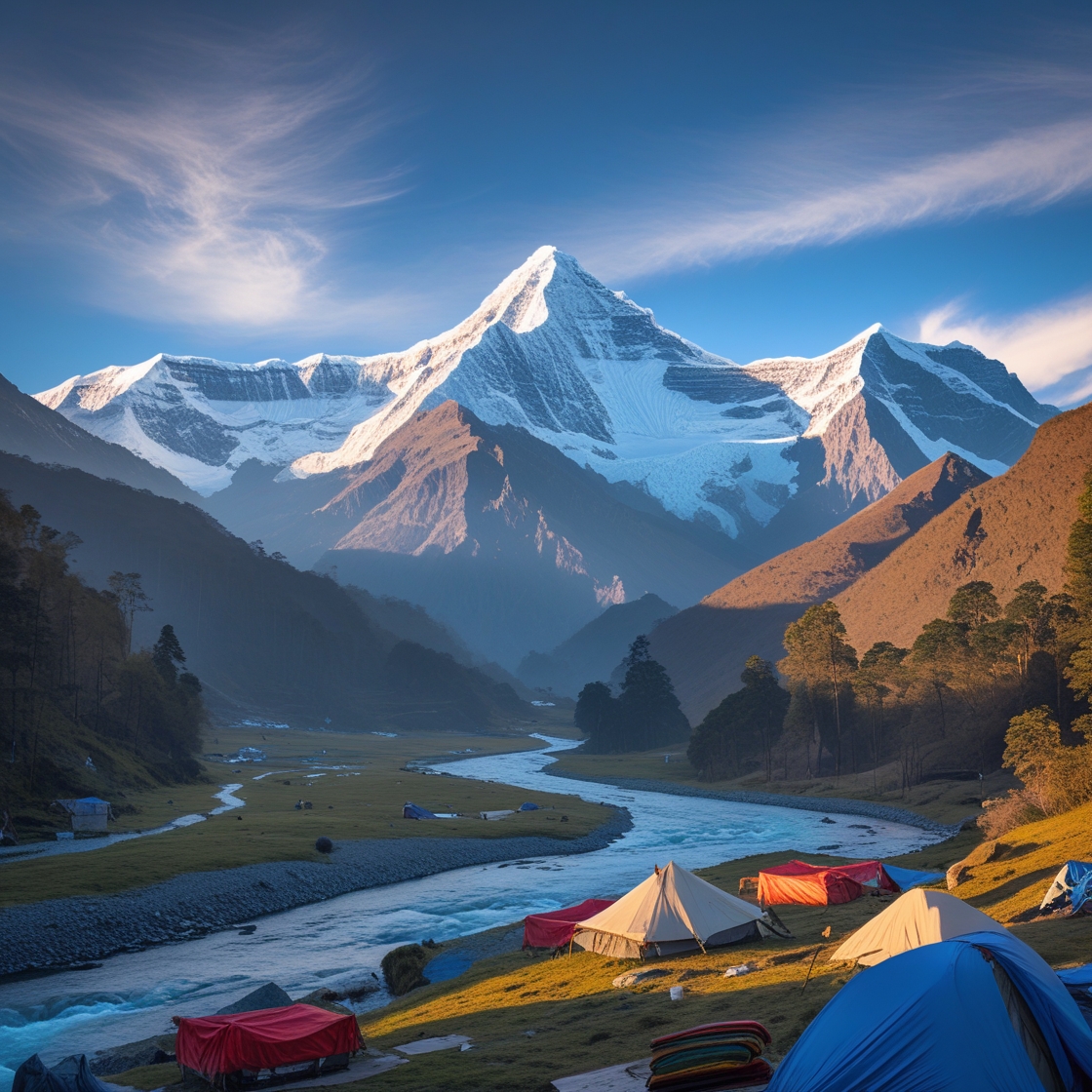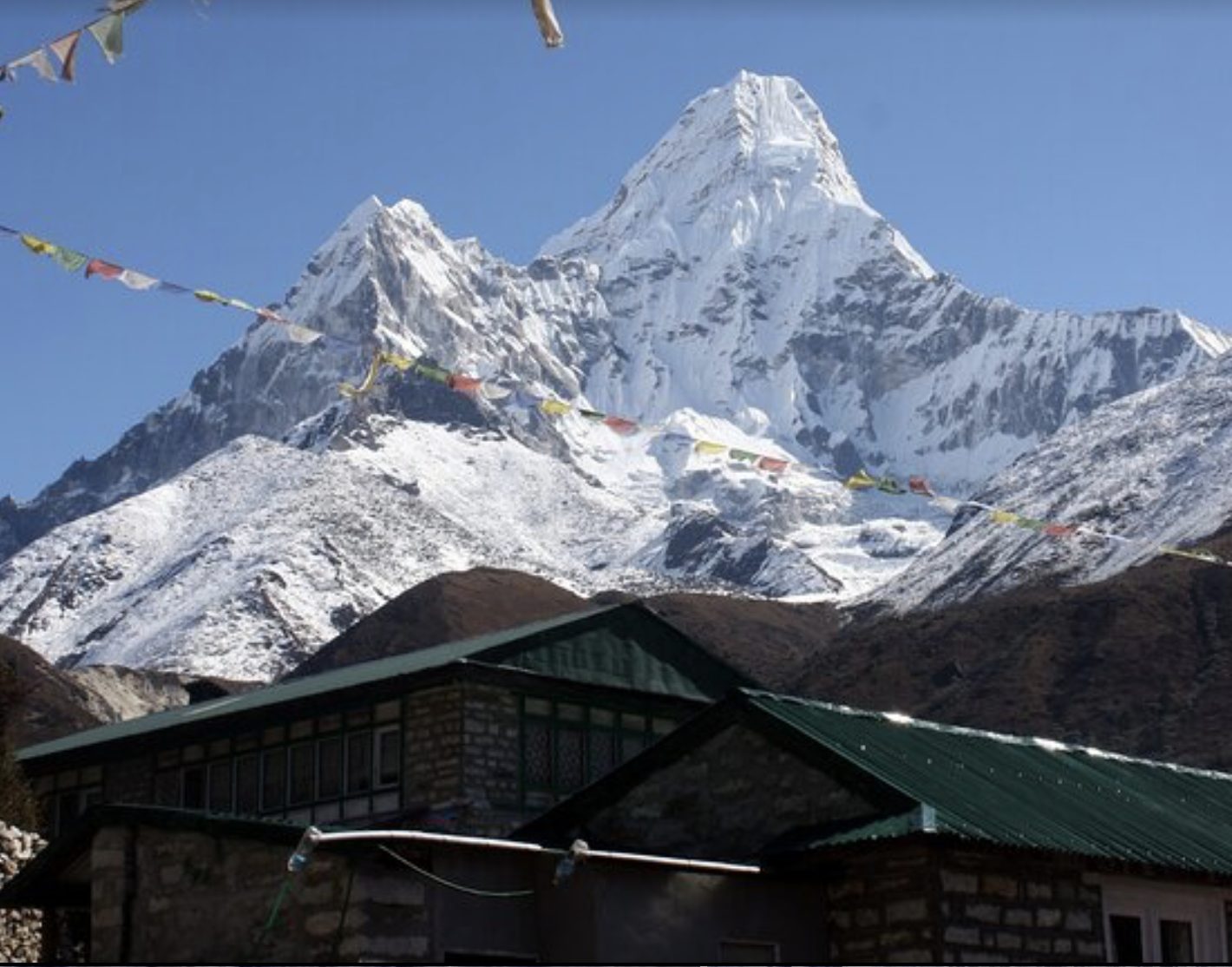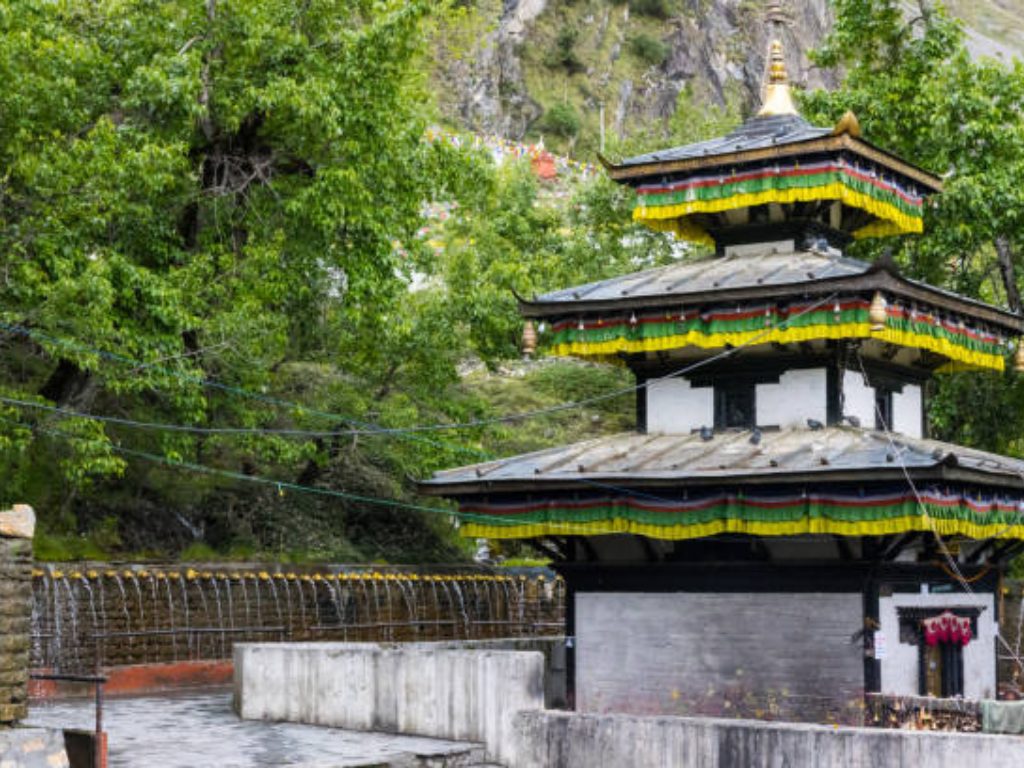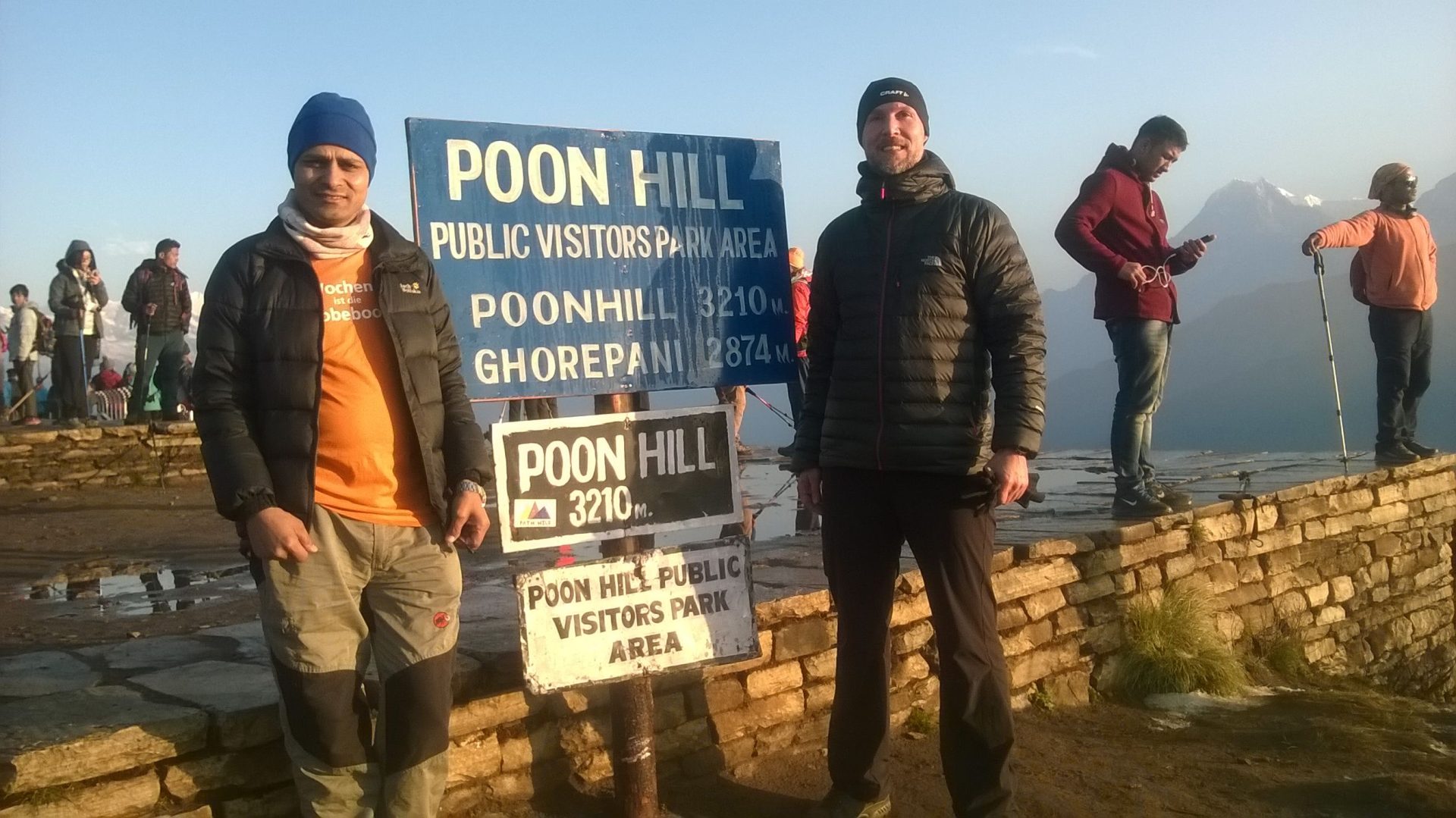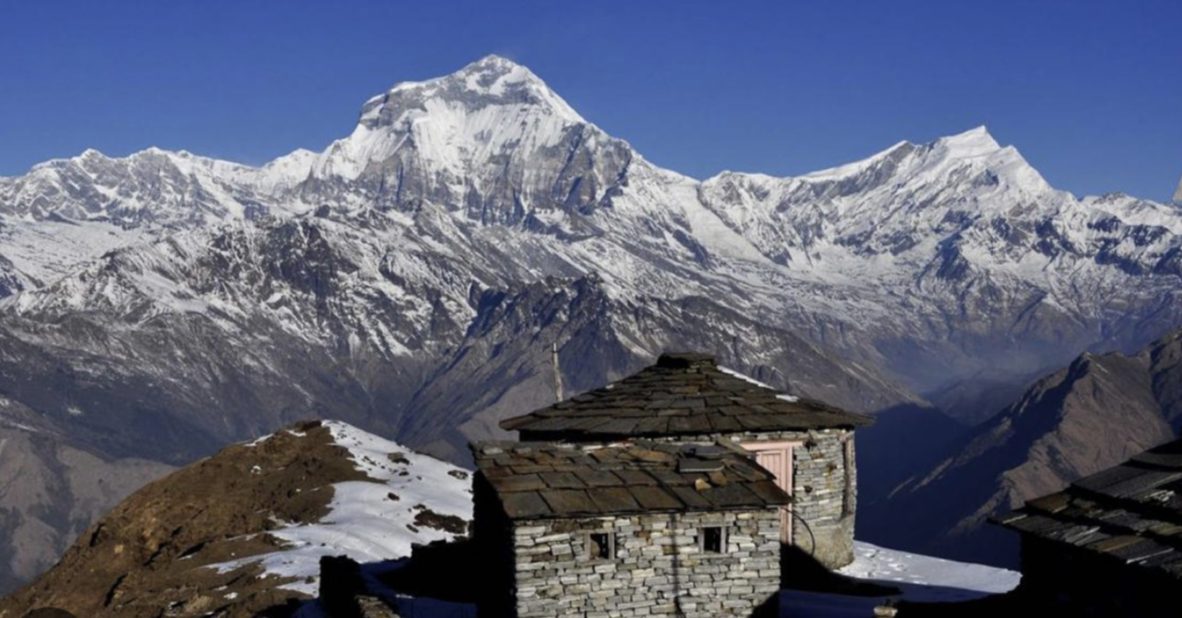Kanchenjunga North Base Camp Overview
Kanchenjunga North Base Camp trek in Nepal
Kanchenjunga is the best and popular trekking region which provides different opportunities to the trekkers. The diverse and fascinating landscapes passes through a Conservation area of wide variety of flora and fauna, river valleys, waterfalls, and high passes. Here is an abundant variety of wildlife the elasive snow leopard, the Asian black bear, and red panda, and some of the more rare mammals. Bird lovers may get the chance to see the golden-breasted fulvetta, snow cock, and blood pheasant among others. Furthermore, on the trail at the foothills of mountains, where the temperature is moderate, vegetation such as temperate forest, scrubland, tundra is seen. Similarly you can also witness mountain habitat animals such as black bears, wolves, mountains goats, elk etc. In Kanchenjunga Conservation area, you can explore deciduous oaks, maples, laurels, and briches intersperse with evergreen firs, mangouas, junipers and rhododendrons.
The ‘King of the Mountains’ or Kanchenjunga (8586m) is the third highest mountain in the world, located in the eastern Himalayans on the border between Sikkim state, north eastern India, and eastern Nepal 46 miles (74km) north-northwest of Darjiling, Sikkim. It is also known by different names in different regions. The name Kan-mean head, Chen-mean belly and Jungha-mean knee. So if you can clearly view this three top at the same time, you could see that Buddha is sleeping. That’s why this hill is also known as sleeping Buddha. In Nepal it is also known as Kumbhkaran Lungu.
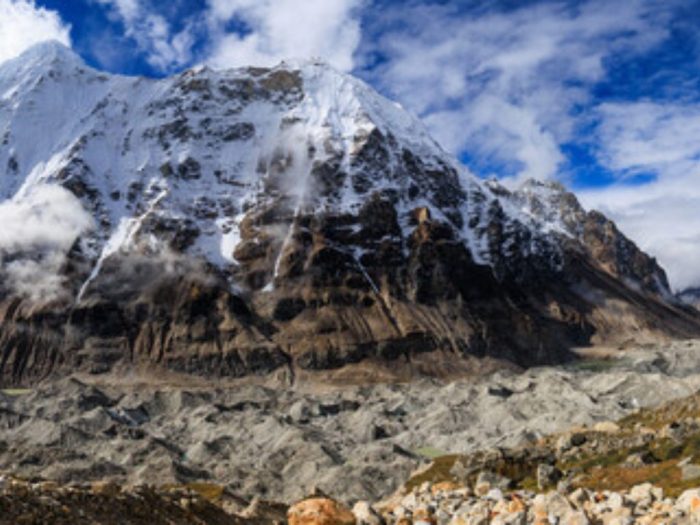
Culture and Religion
Kanchenjunga trek offers you multicultural people living together, mainly Rai, Limbu and Sherpa. In this region most of the people follow Buddhism and have great faith in it. People living here also celebrate their important festival Udhaili and Ubhauli yearly. These people fulfill their livelihood with farming, animal husbandary, and service in Gurkha regiment (mostly in Indian army) as well as working abroad. Additionally they collect seasonal herbs and trade in the market as well as make Homeopathy medicine. You can explore yak and sheep gardening in the alpine climate and they also grow potatoes, wheat and buck wheat.
Favorable time to trek
Every season is suitable for trekking to Kanchenjunga North Base Camp but the best time gives you best experiences. So the peak seasons for trekking to the Kanchenjunga region are during the spring (March to May) and the autumn (September to November). This time provides the best scenery and the clearest skies, but of course, you will meet more trekkers in this season than the off season.
Similarly, it is possible to trek during the winter (December to February). In this season the temperature is low and you may feel cold. On the other hand it is also possible to trek during the monsoon (June to August), though the views are covered by clouds and there is a high chance of rainfall and landslides.
Accommodations at Kanchenjunga north base camp trek
During the trek, our guide will select the best lodge for you to stay in based on their experience and availability of a room. When you are in Kathmandu, we will provide a 2-3 star hotel for you. You have wide range accommodation option in the towns like Bhadrapur and Taplejung. But in the mountains the accommodation will be very basic. The room is relatively comfortable and clean in the town then mountains and remote villages. All the accommodation will be a twin-shared basis.
The standard lodge has two single bedrooms with complementary blanket and a pillow. In the mountain shower and toilet will be on sharing basis. If you do Kanchenjunga trek during the peak season there is a high chance to share the room with another group. Sometimes there is also chance to sleep in the dormitory because of the limited tea houses.We are experienced to organize Kanchenjunga trek with best accommodation and arrange the comfortable rooms according to our group size.
Healthy Meals available at Kanchenjunga north base camp trek
Kanchenjunga region has a wide variety of food and it is easy to serve to your needs. On the trek, breakfast, lunch, and dinner are provided. For tea house trek, we can order typical Nepali food, continental, Italian, Tibetan and Indian at teahouses. All the food will be cooked by the local cook by using local vegetables so the taste would be very local.
During your time in the hotel in Kathmandu, your breakfast is included. Lunch and dinner must be covered on your own. If you are a vegetarian/ vegan, gluten or lactose free, we are able to work around that if you let us know ahead of time.
Acclimatization / Fitness/ Experience on Kanchenjunga north base camp trek
More important than fitness or experience is one’s personal determination and positive attitude toward finishing and enjoying the trek because as many of our treks lead us high into the Himalayans. Our Kanchenjunga North Base Camp trek have one or two acclimatization days built into the itinerary to prevent altitude sickness and let our bodies our bodies sufficiently get used to the altitude. The level of fitness varies depends upon the trek. A person should be able to walk 5-6 hours per day while on the trail.
Guide and Porter for the safety Kanchenjunga north base camp trek
According to Nepal government policy all the trekking activities should be conducted along with a government-licensed guide and porter. Your safety is our first priority. So our guide and porter are dedicated to making your experience of trekking in Nepal a memorable one without compromising your safety. Along with your safety we also focus on our guide and porter safety too. Notably, we have done insurance of our guide and porter.
Travel Insurance Kanchenjunga north base camp trek
We strongly recommend you to get travel insurance before going on a trek. Make sure that, your insurance covers accidents abroad and high in the mountains. We do our best to take care of you, but sometimes we have to face unavoidable accident that is out of our control. So in case of a medical emergency, leading to a helicopter evacuation, it is best to have insurance.
Kanchenjunga North Base Camp Highlights
- Walk past the alpine meadows and high-altitude wetlands are the most exotic surrounding.
- Explore many more stunning views and enjoy the trek route before reaching the base of the world’s third highest peak.
- Walk around the conservation area.
- Click astonishing photographs of a variety of flora and fauna inside the conservation.
- Explore ancient monasteries, mani walls, prayer flags, and chortens.
- Enjoy the amazing cultures and meet warm-hearted people (Rai, Sherpa, and Tamang) of the region.
- Walking to the seas of ice and glaciers on the lap of Mt.Kanchenjunga.
- Trek leads near the borders of Sikkim and Tibet.
Important Notes
Nepal Holiday Treks and Tours Pvt. Ltd. has years of experience with Himalayan trekking and can help make some enduring memories for you as a visitor. For a comfortable and laid-back trekking experience, we have optional services for which you may choose below.
✅ Porter Service – USD $Let’s relax and stroll in comfort! Our porters are professional and can handle a maximum of 25 kg of luggage, which can be shared between two travelers. Enjoy the stunning views without the burden of heavy gear.
✅ Private Jeep Transfers – USD $
Enhance your trekking experience by taking a private jeep transfer to and from trek starting points, in a comfortable and hassle-free manner without using public means of transport.
✅ Helicopter Return Facility – USD $
For those on a time crunch and seeking a luxurious end to their trek, we offer helicopter return services from top locations such as Annapurna Base Camp, Samagaun (Manaslu region), and Kyanjin Gompa (Langtang region). Enjoy thrilling bird’s eye views of the Himalayas while saving travel time.
✅ Upgraded Accommodation – USD $
Upgrade your trek with enhanced lodges having attached bathrooms strategically located. Enjoy more comfort and relaxation after tired trekking days.
✅ Extra Night in Kathmandu – USD $/night
Early arrival or extended stay? Add extra nights at our partnered 3-star hotel in Kathmandu, with breakfast, to relax prior to or post-trekking.
How to Customize Your Trek:
- Choose Your Trek Departure Date.
- Specify the Number of Travelers.
- Click ‘Book Now’ or ‘Add to Cart.’
- Choose Your Preferred Add-on Options.
- Complete Your Booking and Payment.
Required Experience:
This trek is ideal for active trekkers who can hike 6 to 7 hours a day carrying a light daypack. On certain days, the trekking is longer and the altitude increases the difficulty level of trekking. The trails are generally good, but there could be boulder and uneven patches in between.
Itinerary and Schedule: We try to follow the itinerary planned; yet trekking in distant mountain regions means uncertainty. Factors such as weather and trekkers’ well-being may make readjustments necessary. Your guide and Sherpa crew will try to stick to the trail as designed but flexibility is a must. Your safety is our topmost priority and also to get you back to Kathmandu before your scheduled departure.
What will the temperature be like during trek?
Weather conditions can vary significantly depending on the season and can change rapidly, especially at higher elevations. If your trek takes you above 3,000m, you should be prepared for temperatures ranging from -10°C to 25°C in a single day. It’s essential to have proper protection against sun exposure and strong winds. For helpful weather insights, refer to reliable source. Feel free to reach out to us for a recommended packing list tailored to your trekking itinerary.
How much money should be we bring?
You’ll require Nepali Rupees for any expenditure not covered by your package itinerary. Such costs might include bottled water, night hot shower, extra snacks, extra hot drinks, repairing or replacing equipment, battery charging, souvenirs, and tips. In case you want to shop, Thamel is an excellent place to shop on your last day. You are welcome to come to our office prior to your trek for individual counsel and assistance with money exchange.
Electricity, telephone, and internet access are available at most lodges and guesthouses along the Kanchenjunga north base camp trek, but with some additional charges. While the trek itself does not have widespread access to electricity, many lodges rely on solar power or generators to provide energy. You can recharge your devices like cameras, mobiles, and laptops at these places, although it usually comes at an extra cost. If you need to make phone calls or access the internet, some accommodations offer limited telephone and Wi-Fi services. You can obtain an internet password from the lodge, but keep in mind that these services typically incur additional fees.
Fill your life with adventures, not things. Have stories to tell, not stuff to show. Hurry up! Adventure is waiting for you and mountains are calling you.
This trip is fully customization. Importantly, this trip is available on both a fixed departure and a private group basis. Moreover, we can also customize the trip as per your needs, please contact us at Whatsapp (+977-9843770916) or email us at [email protected]. Let us know how we can help you, and we will do our best to give you the best customer service you’ll get anywhere else.
Furthermore, Nepal holiday treks and tours Pvt. Ltd. is a reputable and reliable company serving relentlessly in the field of tourism to fulfill the dreams of diverse adventure seekers around the globe into reality where they can feel most alive. So, we recommend you to reserve seat for yourself by booking with us right away for a wonderful and unforgettable trip experience.
Kanchenjunga North Base Camp Itinerary
Expand allDay 01: Arrive at Kathmandu and Transfer to hotel
Our personnel will be waiting for you at the airport with your name on a placard. He will pick you up from airport and transfer you to the hotel as per your preference. This day will be for your refreshment and in the evening you will be provided a guided evening walk to the local markets as well as localities to make you familiar with the Nepalese atmosphere.
Day 02: Preparation Day for the Trek
The Kanchenjunga North Base Camp preparation day is essential to guarantee a trouble-free and fruitful expedition. We’ll do a comprehensive equipment check on this day to make sure everyone has the right trekking boots, warm layers, and rain gear, among other essentials. We’ll also go over the itinerary for the trek, safety procedures, and advice on acclimatization to get you ready for the challenges of high altitude that lie ahead. We’ll also address any last-minute queries or worries and give you the chance to take a quick walk to warm up your muscles. Our aim is to make sure you’re ready for an incredible journey in the breathtaking Himalayas, both physically and mentally.
Day 03: Fly from Kathmandu to Bhadrapur (43 min) and Drive to Taplejung by Jeep(10 hours)
The journey starts with a picturesque 43-minute flight from Kathmandu to Bhadrapur, which offers breathtaking ascent views of the Himalayas. After landing, we’ll travel to Taplejung by jeep for ten hours, passing through charming towns and scenic landscapes. Even though the drive is lengthy, it offers a singular chance to take in the varied beauty of Nepal’s countryside and gain a deeper understanding of rural life. Even though the road can be rough, the journey is made more memorable by the picturesque route and cozy jeep.
Day 04: Trek from Taplejung to Tapethok (5 hours)
The five-hour hike from Taplejung to Tapethok today offers a fascinating tour through verdant surroundings and historic villages. Along the way, you’ll get a taste of the lively local culture and take in the breathtaking scenery, which includes thick forests and terraced fields. The trail gently undulates, giving us time to adjust to the altitude and enjoy the tranquil surroundings. On our way to our quaint destination, Tapethok, where we’ll rest and recharge for the adventures ahead, keep an eye out for the local wildlife and take in the gorgeous scenery.
Day 05: Trek from Tapethok to Amjilosa (6 hours)
Our six-hour hike from Tapethok to Amjilosa today will take us even further into the heart of the Kanchenjunga region. With its steady ascent through verdant forests and beside rivers, the trail offers amazing views of the neighboring mountains. As we travel through this varied terrain, we’ll pass through quaint hamlets and learn about the Sherpa culture of the area. There are many opportunities to take in the breathtaking scenery and natural beauty of the Himalayas during this exhilarating and picturesque journey. You’ll be rewarded with a warm, traditional setting as we arrive at Amjilosa, where we can unwind and get ready for the next leg of our journey.
Day 06: Trek from Amjilosa to Gyabla (5 hours)-2730m
We will hike for approximately five hours today, covering 2,730 meters from Amjilosa to Gyabla, passing through some breathtaking scenery. You’ll notice that as we climb, the landscape gradually opens up from thick forest to wide-open spaces, with sporadic views of the surrounding towering peaks. Along the way, we’ll pass through a number of quaint traditional villages and see terraced fields that provide a window into daily life. We can comfortably acclimate to the steady climb, and when we arrive at Gyabla, you’ll be treated to a warm welcome and breathtaking views that are ideal for unwinding and taking in the area’s natural beauty.
Day 07: Trek from Gyabla to Ghunsa (5-6 hours)-3550m
At an elevation of 3,550 meters, the hike from Gyabla to Ghunsa today will take five to six hours. This trip offers a dynamic combination of environments, beginning with a gentle climb through terraced fields and verdant rhododendron forests. The landscape opens up as we ascend, revealing traditional mountain villages and breathtaking views of the mountains. The trail helps your body acclimate to the altitude while offering plenty of chances to take in the serene beauty of the Himalayas. You’ll experience a cozy, highaltitude sanctuary with stunning views upon our arrival in Ghunsa, which will prepare you for the next part of our journey.
Day 08: Trek from Ghunsa to Khambachen (Rest day)-4000m
We will hike for four to five hours today, from Ghunsa to Khambachen, reaching an elevation of 4,000 meters. This hike passes through breathtaking high-altitude scenery, with rocky trails and expansive alpine meadows that provide breathtaking views of the surrounding peaks. You will notice that the air is getting thinner and the scenery is getting rougher as we ascend. We’ll take a well-earned rest day in Khambachen to explore the area and get used to the altitude. Your body can adjust during this rest, making you ready for the higher altitudes and more difficult portions of our journey ahead.
Day 09: Trek from Kambachen to Lhonak (5-6 hours)
The five to six-hour trek we have planned today will take us from Khambachen to Lhonak, passing through some of the most spectacular high-altitude scenery in the Kanchenjunga region. You will experience steep terrain and wildflower-filled alpine meadows as we climb, all the while taking in breathtaking views of the towering peaks that line our path. Take your time and drink plenty of water because the air will be thin. You will be rewarded with a breathtaking vantage point to enjoy the breathtaking mountain scenery and the tranquil atmosphere of this isolated alpine settlement upon arriving at Lhonak.
Day 10: Trek from Lhonak to Pangpema (North Base Camp) -5143m
The highlight of our journey so far has been our trek from Lhonak to Pangpema, the North Base Camp at 5,143 meters. A 5- to 6-hour strenuous but rewarding hike through bleak, dramatic landscapes is to be expected. The going gets rougher as we ascend, and we are surrounded by expansive views of glaciers and high peaks. The path provides amazing views and a deep sense of being in the heart of the Himalayas. When you reach Pangpema, the sight of Kanchenjunga’s towering north face will astound you, and it’s the ideal place to celebrate the end of our journey and take in the majesty of the Himalayas.
Day 11: Trek from Lhonak to Ghunsa (6 hours)
Our six-hour trek today will take us from high-altitude terrain down through a variety of breathtaking landscapes back to Ghunsa from Lhonak. The route descends gradually through rocky paths and scenic alpine meadows, offering expansive views of the Himalayas. You’ll be able to appreciate how the mountains we’ve explored have changed in perspective as we make our way back through the picturesque terrain. The trip offers a blend of scenic beauty and cultural insights, culminating in a return to Ghunsa, where we’ll unwind and reminisce about our adventure in the cozy setting of a mountain village.
Day 12: Trek from Ghunsa to Amjilosa (6-7 hours)
Our six to seven-hour hike today, which departs from Ghunsa and ends in Amjilosa, takes us on a picturesque descent through the lush, green scenery of the Kanchenjunga region. You’ll gradually transition from high-altitude terrain to thick forests and quaint village scenery as we descend. The route offers a welcome diversion from the higher altitudes as it winds through scenic valleys and alongside serene rivers. You will have experienced a rewarding and varied trek with many chances to take in the area’s natural beauty and rich cultural heritage by the time we arrive at Amjilosa.
Day 13: Trek from Amjilosa to Tapethok (6 hrs walk)
The six-hour hike from Amjilosa to Tapethok today offers a beautiful and energizing descent through the verdant Kanchenjunga region. You will take in the vivid greenery of terraced fields and forests, as well as the calming sounds of rivers and wildlife, while we stroll. The majority of the route is downhill, offering a relaxing conclusion to our journey with frequent views of nearby villages and traditional life. You’ll have traveled a satisfying distance by the time we arrive in Tapethok, and we’ll have time to unwind and consider the incredible journey we’ve just finished.
Day 14: Drive from Tapethok to Bhadrapur by jeep
We’re going to take a leisurely 10-hour scenic jeep drive from Tapethok to Bhadrapur today. We travel through an enthralling variety of landscapes on this drive, from colorful local villages to verdant hills and terraced fields. Even though the trip is lengthy, it provides a wonderful chance to witness rural life and appreciate Nepal’s varied natural beauty. As we travel to Bhadrapur, you can unwind and take in the constantly changing scenery from the comfort of our cozy jeep.
Day 15: Fly from Bhadrapur to Kathmandu (1300m)
We will take a quick, forty-three-minute, thrilling flight from Bhadrapur back to Kathmandu today. This flight gives us a unique perspective on the various landscapes we’ve traveled through and a breathtaking aerial view of the Himalayan foothills. Views of verdant valleys, meandering rivers, and, weather permitting, the towering peaks of the Himalayas will be visible to you as we soar above. As we descend to 1,300 meters and return to the lively energy of Nepal’s capital city, you’ll have time to relax and think back on the amazing journey we’ve just been on.
Day 16: Final Departure to Tribhuwan International Airport
We’ll head to Tribhuvan International Airport for your last departure as our adventure draws to an end. We’ll make sure you have all required paperwork and help you with any last-minute details. While getting ready to board your flight, pause to think back on the amazing trip we’ve taken through Nepal’s breathtaking scenery. It’s been an amazing experience, taking me from the colorful streets of Kathmandu to the serene heights of the Himalayas. We hope that the experiences from this journey will stick with you long after you’ve departed and wish you safe travels.
If the above Everest Base Camp Trek itinerary does not meet your needs, we can design individualized travel plans based on your preferences and specifications.
Plan My TripKanchenjunga North Base Camp Cost Includes
- Pick up and drop from and to the airport by private vehicle
- Three times Three meals a day- Breakfast, Lunch, Dinner and 3 cup’s of tea/Coffee a day during the trek.
- Accommodation in tea house during the trek.
- In a day time tea break with cookies every day.
- Seasonally fruits and desserts on the trek after dinner every day.
- You will be under observation with a pulse oximeter to have your oxygen levels and heart rate measured twice a day during the trek. This is to catch the signs of Altitude Mountain Sickness (AMS) early, thus making trekking safer.
- Nepal Holiday Treks and Tours, (-20 degree sleeping bag) and a duffel bag for the trekking, but you need to refund to the office after the trip.
- An experienced, helpful, knowledgeable, friendly, English-speaking, well-trained, government license holder Guide with all his salary, food, Drinks, accommodation, equipment, transport, and insurance.
- National Park permits and special trekking permits.
- Normal First aids kit box.
- Arrangement of Emergency helicopter service (paid by your travel insurance company).
- All taxes and company service charges.
- Nepal Holiday Treks And Tours trip completion certificate from the company side.
- All taxes and company service charge.
Kanchenjunga North Base Camp Cost Excludes
- International airfare and visa fees
- Lunch and dinner in Kathmandu
- Personal expenses of bar and beverage bills, wifi, hot shower, bottle of water, extra porters, laundry or any other things which are not mentioned by the company
- Your trekking gears and extra nights in a certain destination
- Your travel insurance which should include the emergency rescue
- Tips for your guide and porters or anyone during the trip
- Entrance fees during the sightseeing
- A strong, helpful, porters with proper safety equipment and walking equipment his salary, food, drinks, accommodation, insurance, (one porter for two people he will carry bag pack max 20-25kg).
- Extra charges due to any events such as strikes, weather conditions or flight delays
Upcoming Departures
Customer Reviews
Write a ReviewKanchenjunga North Base Camp FAQs
Why trek with Nepal holiday treks and tours?
We have a great track record of leading treks with experienced and qualified guides, so all your travel needs are professionally taken care of. We are a certified sustainable travel operator and are committed to responsible tourism and actively contribute to the local community through various Trekking.
Do I Need Prior Trekking Experience?
No prior trekking experience is required. You can easily do the trek if you are physically fit and have an adventurous spirit.
What Kind of Physical Conditioning is Required for Preparing for a Trek?
To prepare for the trek, we recommend a combination of cardiovascular exercise, strength training, and endurance-building activities. Regular hiking, running, stair climbing, or biking can increase your endurance. Strength training exercises that focus on legs, core, and overall body fitness will help you cope with the strain of high-altitude trekking.
Can I Rent a Sleeping Bag, Down Jacket, and Duffle Bag?
Yes, sleeping bags, down jackets, and duffle bags can be hired. for the trekking but you need to return to the office
Is There a Place to Store Things Not Needed for the Trek?
Yes, most hotels in Kathmandu provide free storage facilities where you can leave any items that you will not be needing during the trek.
What Should I Do with My Passport, Medications, and Other Valuable Belongings?
It is advisable to carry a copy of your passport, travel insurance, and other important things in your daypack. If you are taking any daily medication, please bring it along with you in your daypack for your ease. You can leave unnecessary stuff in your hotel or our Kathmandu office safely.
Is It Possible to Get Private Rooms During the Trek or in Kathmandu?
Private rooms in teahouses along the hiking trail cannot be guaranteed, especially during the high seasons. You may get private rooms without any extra fee during the off-season. Most of the teahouses have twin-sharing rooms, with dormitory-style accommodation in some areas. If you wish to get a private room in Kathmandu, we can arrange that for an added fee per night.
Do Your Guides Have Official Trekking Certifications and First Aid Training?
Yes, our trekking guides are professional-grade license holders certified by the Hotel Management and Tourism Center. They have completed a 45-day intensive training course and are specialists in high-altitude first aid. They are English- and other language-speaking (on request at an additional cost).
What If I Fall Sick in the Mountains?
Our guides are on standby 24/7 to assist you. They carry a first-aid kit and an oximeter to measure oxygen levels, to ensure that trekkers are in a fit state to carry on. In the event of serious altitude sickness or any other serious medical condition, our guides will immediately call our Kathmandu office. We are prepared to arrange emergency transportation, or helicopter evacuation if necessary.
What is Your Cancellation trip?
There is no refund of a 20% deposit fee in the cancellation of the trip due to any other reason but we welcome rescheduling your trip on any future day. After paying the full cost of any trip, you will receive a refund but the cancellation charge 20% is deducted from you. You have to give written notice of cancellation in order to cancel any trip.
Why Choose Our Trekking Services?
Our company has a high success rate of organizing successful trekking trips with highly experienced and well-trained guides. We are expert in client safety, satisfaction, and responsible tourism. Beyond adventure, we also practice giving back to the local communities through various social activities, so that our travel experiences make a positive impact on the region.
What should I know about booking my flights to / from Nepal? Di I need to plan extra days in case of delays?
We recommend adding a one- to two-day buffer period before and after your trek in case of unforeseen flight delay, especially in remote areas like Lukla. This also leaves some time to buy last-minute gear. We are not responsible for missed overseas flights due to unforeseen cancellations or delays.
What is the temperature rating of the sleeping bag that you lend to trekkers?
The sleeping bags we provide for trekkers are designed to withstand temperatures of up to -10°C (14°F). If you require more heat, our guides can arrange additional blankets at the teahouses on the trekking route.
What sort of insurance do I need? How can I obtain a policy?
Travel insurance is an absolute necessity for all of our trekking trips. Your policy must include medical evacuation to the highest altitude that you will reach on your trek. It should also include coverage for unexpected expenses such as flight cancellations due to bad weather, medical attention, theft, loss, or damage to your belongings. Good travel insurance companies usually offer policies online so you can purchase coverage in advance.
What are the necessary items that I should pack for my trip?
For a full list of equipment required, refer to the Equipment page. If you prefer to buy or hire trekking equipment in Kathmandu, ensure you set aside extra time before beginning your trek.
What type of daypack should I bring?
When selecting a daypack, pick one that is light in weight but that still has enough space to bring your daily essentials such as water, snacks, extra clothing, and personal items.
Is it necessary to bring toilet paper for the trek?
While you can purchase toilet paper at teahouses throughout the trek, it is costly. We recommend that you bring your own supply. Additionally, don’t forget to bring personal hygiene products like soap, towels, hand sanitizer, and wet wipes.
If I am sick can I continue the trek after a day’s rest?
If you fall ill, the decision is based on your status. Altitude sickness requires an immediate descent to a lower elevation, and recovery can take several days. For group trekkers, inquire with your guide whether it is possible to rejoin the group. Private trekkers with a flexible schedule can possibly resume once they recover.
What kind of trekking boot would be best for the trek?
Proper footwear is crucial for an effective trek. Invest in sturdy, comfortable trekking boots with a water-resistant lining. Hard-solved ankle-supported boots are ideal for trekking over rough terrain, allowing comfort and stability on the trail.
Kanchenjunga North Base Camp Equipment Lists
- General info:
- Sleeping Bag and duffle bag: Four-season sleeping bag with a rating of -20°C by company after you have to refund on company.
- Insulated Jacket: A puffy and warm down jacket suitable for winter by company after you have to refund on company.
- Daypack: 25-30 liter backpack rain cover to carry one’s daily essentials
Clothing:
- Thermal base layers
- Trekking shirts (quick-dry)
- Fleece jacket and down jacket
- Waterproof jacket and pants
- Trekking trousers
- Gloves (inner and outer)
- Warm hat and sun hat
- Trekking socks
Footwear:
- Sturdy trekking boots
- Camp shoes/sandals
- Gaiters (optional)
Accessories:
- Trekking poles
- Backpack (50-60L) and daypack (20-30L)
- Sunglasses (UV protection)
- Headlamp with extra batteries
- Water bottles and purification tablets
Similar Tours
Short Manaslu Tsum Valley Trek
An 17 days trek, the Short Manaslu and Tsum Valley Trek engages trekkers to an adventure close to Mt....
Gokhyo-Renjola Pass trek
Your getaway from the typical trekking route to Everest Base Camp is the Gokyo Renjo-La Pass Trekking. This trekking...
Jomsom Muktinath Trek
Nepal is a stunning country in the Himalayas with magnificent mountains. These mountains’ foothills make for ideal walking terrain....
Ghorepani-Poonhill-Ghandruk Trek
The sheer grandeur of Nepal’s many landscapes and geographical features makes it unimaginably beautiful. There are many interesting, quaint,...
Khopra Danda Trek with Khayer Lake
One of the most beautiful trekking routes in the Annapurna region is the Khopra Danda Trek. For trekkers who...

